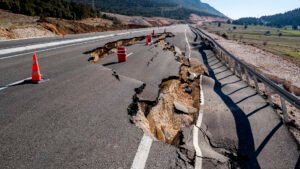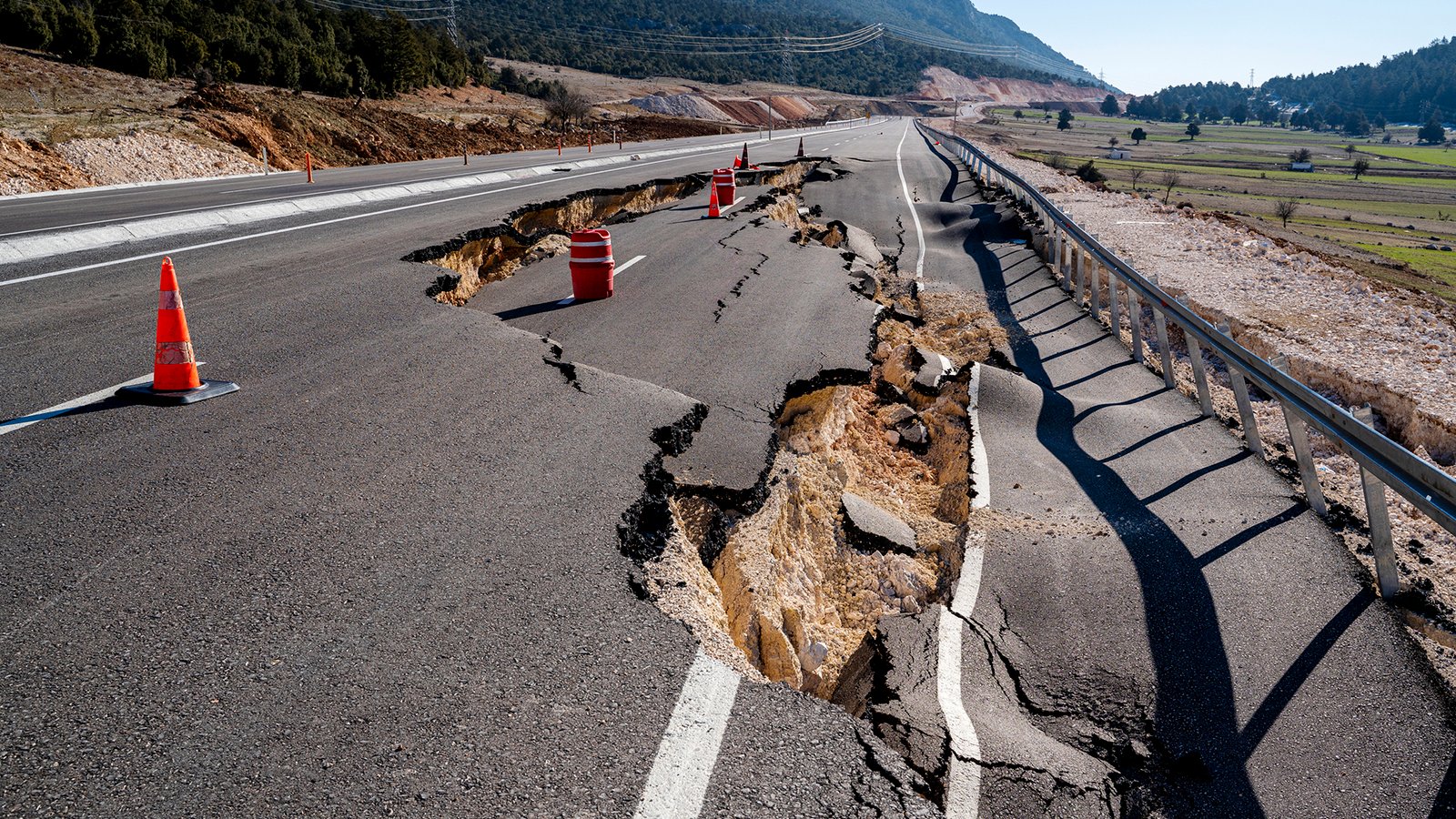
I am going to give you point-by-point details about earthquakes today:
1. Explanation
One of the features of an earthquake is the sudden trembling or shaking of the earth’s surface. The Earth releases energy that travels through the ground as seismic waves, causing this geological phenomenon.
2. Factors
Tectonic plate movement beneath the Earth’s surface is the main source of earthquakes. The lithosphere of Earth is divided into large and small divisions called tectonic plates. These plates are always moving, and their interactions with one another could cause them to slide, collide, or split apart. Abrupt ruptures caused by stress accumulation at plate boundaries or within the plates themselves can cause an earthquake.
3. Center of attention and epicenter:
The point inside the earth where an earthquake initially occurs is known as the focus, also known as the hypocenter. It usually resides several kilometers beneath the planet’s surface. The spot directly above the focus on Earth’s surface is known as the epicentre. An earthquake’s epicentre is usually the location of its highest magnitude.
4. Amount of Magnitude
The magnitude of the earthquake determines the amount of energy released during the seismic event. A common method for putting a numerical value on an earthquake’s magnitude is the Richter scale. An additional widely utilized scale is the moment magnitude scale (Mw). Both scales provide information about the magnitude and potential impact of the earthquake.
5. Earthquakes:
Earth vibrates as a result of earthquakes, producing waves known as seismic waves. There are several different types of seismic waves, including P- and S-waves, or primary waves. P-waves are compressional waves with a higher speed of passage through liquids and solids. S-waves are slow-moving shear waves that only penetrate solid objects.
6. Impacts on Frameworks:
The shaking caused by seismic waves can have a major effect on structures and buildings. Several factors determine the impact of an earthquake, including its magnitude, depth, distance from the epicentre, and local geological features. In earthquake-prone areas, building codes and regulations are implemented to enhance structural resilience, as poorly constructed buildings are more vulnerable to damage.
7. Earthquakes and Aftershocks
An earthquake’s main shock is followed by smaller seismic events called aftershocks. These occur as the earth’s crust adapts to the modifications caused by the initial earthquake. Aftershocks can occur days, weeks, or even months after the initial earthquake and can still cause damage to already-weakened structures despite usually being less powerful than the main earthquake.
8. Tsunamis and earthquakes:
Underwater earthquakes, especially those that occur near tectonic plate boundaries, have the potential to cause tsunamis. Large ocean waves, sometimes referred to as tsunamis, have the ability to travel great distances and inundate coastal areas. A tsunami’s first wave can be incredibly destructive, but it also has the potential to trigger further surges.
9. The Ring of Fire:
The horseshoe-shaped Ring of Fire in the Pacific Ocean basin is well known for its active volcanoes and seismic activity. It encompasses regions such as the western coasts of both continents, Southeast Asia, Japan, and the coasts of North and South America. It is connected to the margins of several tectonic plates, the Pacific Plate among them.
10. Observation and Forecast:
Scientists monitor and quantify seismic activity worldwide using seismometers and other instruments. By analyzing seismic data, researchers can identify patterns, identify earthquake-prone areas, and assess the probability of additional earthquakes. Even though it is still difficult to predict when and where an earthquake will occur, continuous monitoring aids early warning systems and preparedness efforts.
11. Historical earthquakes:
Numerous earthquakes throughout history have impacted communities profoundly and influenced how we perceive seismic events. The 1906 San Francisco earthquake, which resulted in extensive damage and advanced earthquake engineering and urban planning, is one prominent example. The 2010 Haitian earthquake highlighted the susceptibility of some areas to seismic catastrophes more recently.
12. Preparedness and Mitigation:
Regions susceptible to earthquakes take a number of precautions to lessen the possible impact of seismic events. Enforcing building codes and construction regulations is necessary to guarantee that structures are strong enough to endure the forces produced by earthquakes. Campaigns to raise public awareness of earthquake safety emphasise the need to “Drop, Cover, and Hold On” in the event of a seismic event. A community’s readiness for earthquakes must include both emergency response plans and regular earthquake drills.
13. Earthquake Early Warning Systems:
Early warning systems for earthquakes have been developed as a result of technological advancements. These systems identify the first, less destructive P-waves and issue warnings seconds to minutes before the more destructive S-waves appear. They do this by using real-time seismic data. These systems can buy crucial seconds for people to seek shelter and for automated systems to shut down vital infrastructure, even though they might not be able to prevent earthquakes.
Certainly! Here’s a detailed description of earthquakes, presented in a pointwise format with more than 1000 words:
1. Definition:
- An earthquake is a natural phenomenon characterized by the sudden shaking or trembling of the earth’s surface. This geological event is caused by the release of energy within the Earth, resulting in seismic waves that propagate through the ground.
2. Causes:
- Earthquakes primarily occur due to the movement of tectonic plates beneath the Earth’s surface. The Earth’s lithosphere is divided into several large and small pieces called tectonic plates. These plates are constantly in motion, and when they interact, they can either collide, move apart, or slide against each other. The stress built up at plate boundaries or within the plates themselves can lead to sudden ruptures, causing an earthquake.
3. Focus and Epicenter:
- The point inside the earth where the earthquake initiates is known as the focus or hypocenter. It is usually located several kilometers below the Earth’s surface. The point directly above the focus on the Earth’s surface is called the epicenter. The intensity of the earthquake is often the strongest at the epicenter.
4. Magnitude:
- The magnitude of an earthquake is a measure of the amount of energy released during the seismic event. Earthquakes are commonly measured on the Richter scale, which assigns a numerical value to their magnitude. Another widely used scale is the moment magnitude scale (Mw). Both scales provide an indication of the earthquake’s size and potential impact.
5. Seismic Waves:
- Earthquakes generate seismic waves, which are vibrations that travel through the Earth. There are different types of seismic waves, including primary waves (P-waves) and secondary waves (S-waves). P-waves are compressional waves that travel faster and can pass through both solids and liquids. S-waves are shear waves that travel more slowly and only pass through solids.
6. Effects on Structures:
- The shaking caused by seismic waves can have significant effects on structures and buildings. The impact depends on various factors, including the earthquake’s magnitude, depth, distance from the epicenter, and the geological characteristics of the area. Poorly constructed buildings are more susceptible to damage, and in earthquake-prone regions, building codes and regulations are in place to enhance structural resilience.
7. Aftershocks:
- Aftershocks are smaller seismic events that follow the main earthquake. They occur as the Earth’s crust adjusts to the changes caused by the initial quake. Aftershocks can continue for days, weeks, or even months after the primary earthquake, and while they are generally less intense, they can still cause damage to already weakened structures.
8. Tsunamis:
- Underwater earthquakes, especially those occurring near tectonic plate boundaries, have the potential to generate tsunamis. Tsunamis are large ocean waves that can travel across vast distances and inundate coastal areas. The devastating impact of tsunamis is not only due to the initial wave but also the subsequent surges that may follow.
9. Ring of Fire:
- The Ring of Fire is a horseshoe-shaped zone in the Pacific Ocean basin known for its high seismic and volcanic activity. It is associated with the boundaries of several tectonic plates, including the Pacific Plate, and encompasses regions such as the coasts of North and South America, Japan, Southeast Asia, and the western coasts of North and South America.
10. Monitoring and Prediction:
- Scientists use seismometers and other instruments to monitor and measure seismic activity worldwide. By analyzing seismic data, researchers can determine patterns, identify earthquake-prone regions, and assess the risk of future earthquakes. While precise prediction of when and where an earthquake will occur remains a significant challenge, ongoing monitoring contributes to early warning systems and preparedness efforts.
11. Historical earthquakes:
- Throughout history, several earthquakes have left a lasting impact on communities and shaped our understanding of seismic events. One notable example is the 1906 San Francisco earthquake, which caused widespread destruction and led to advancements in earthquake engineering and urban planning. More recently, the 2010 earthquake in Haiti underscored the vulnerability of certain regions to seismic disasters.
12. Preparedness and Mitigation:
- Earthquake-prone regions implement various measures to reduce the potential impact of seismic events. Building codes and construction regulations are enforced to ensure that structures can withstand the forces generated by earthquakes. Public awareness campaigns promote earthquake preparedness, including the practice of “Drop, Cover, and Hold On” during shaking. Regular earthquake drills and emergency response plans are crucial components of community preparedness.
13. Earthquake Early Warning Systems:
- Advances in technology have led to the development of earthquake early warning systems. These systems use real-time seismic data to detect the initial, less-damaging P-waves and provide warnings seconds to minutes before the more destructive S-waves arrive. While these systems may not prevent earthquakes, they can offer valuable seconds for people to take cover and for automated systems to shut down critical infrastructure.
14. Global Distribution:
Although they happen everywhere, the frequency and intensity of earthquakes differ by location. Seismic activity is especially common near tectonic plate boundaries, such as the Pacific Plate boundaries, the Himalayan region, and the Mid-Atlantic Ridge. Intraplate earthquakes, on the other hand, are defined as occurring within tectonic plates, away from plate boundaries.
15. Social and Economic Impacts:
Earthquakes can have significant effects on society and the economy. Beyond the immediate loss of life and property, earthquakes can cause infrastructure to be disrupted, which can have long-term negative effects on the economy. Following a seismic event, affected communities may encounter difficulties, and rebuilding often requires large resources.





